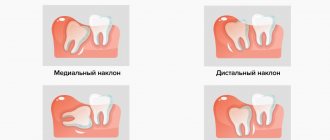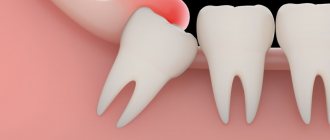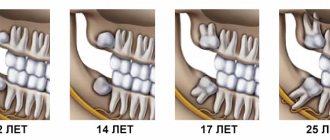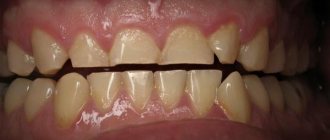Wisdom or 8 teeth can cause a lot of problems, especially if they grow into the cheek. These teeth have no analogues in the primary occlusion, so they erupt through unprepared periodontal tissue, and their growth is accompanied by discomfort even with proper eruption. The growth of eighth teeth can begin at age 17, but there are cases when these teeth remain impacted (not erupted) throughout life.
Symptoms and signs of abnormal growth
It is extremely rare for eights to appear without any complications. This is due, first of all, to the fact that wisdom teeth grow in adulthood, when the jaw is already formed. Even with proper teething, discomfort may still be present for several weeks or months. If a wisdom tooth grows incorrectly or has an abnormal location, then certain symptoms indicate this.
Let's take a closer look at the types of pathologies and symptoms associated with the growth of wisdom teeth.
- Retention is a pathology in which the third molar is located under the mucous or bone tissue. The main symptoms are severe pain in the gums, as well as the development of an inflammatory process in the gum pocket.
- Dystopia or abnormal position of the tooth. It manifests itself as severe pain, affecting adjacent teeth, and the development of inflammation, including phlegmon or osteomyelitis.
The initial alarming symptoms that a patient may identify when a wisdom tooth grows are:
- Swelling in the cheek area.
- When swallowing, severe pain occurs, radiating to the throat or ear.
- Purulent or bloody discharge.
- Injury to the mucous membrane.
If you detect at least one of the above symptoms during the eruption of figure eights, you must seek the help of a dentist as soon as possible. The doctor will conduct an x-ray and determine whether the wisdom tooth is growing correctly.
Symptoms of wisdom tooth eruption
When the coronal part of a wisdom tooth begins to erupt onto the surface of the soft tissues, this process is rarely asymptomatic. The difficulties are largely due to the fact that wisdom teeth do not have milk analogues, so even if the third molars erupt correctly, a person experiences a number of unpleasant sensations.
Signs of wisdom tooth eruption
- Itching in the eruption area (at the initial stage).
- Inflammation of the gums during the eruption of wisdom teeth.
- Aching or throbbing pain in the jaw.
- Pain when swallowing and difficulty chewing food (especially hard food).
- Temperature increase. The temperature during the eruption of a wisdom tooth in adults increases by an average of 1 - 2 degrees.
- Inflammation of the submandibular lymph nodes.
What to do with a bothersome wisdom tooth at home
The most important thing is not to cause further harm to yourself before visiting the dentist. It is extremely important to avoid overheating the area of concern. Heat can accelerate the onset of the inflammatory process. Therefore, you should not apply warm compresses or take a hot bath.
What can you do to relieve pain when wisdom teeth erupt:
- follow a gentle diet (do not eat very hard, hot or cold foods);
- after eating, rinse your mouth;
- use local anesthesia, such as gels used during teething in children;
- In case of severe pain, you can take painkillers.
But the most important thing is not to delay your visit to a specialist! Only he will be able to determine the seriousness of the problem and help avoid possible complications.
Difficulty erupting wisdom teeth
If there are the beginnings of eights, then there are two options: normal eruption of wisdom teeth or difficult. With the first option everything is very clear. But problems during teething may indicate the presence of pathologies - dystopic and impacted wisdom teeth.
Removal of abnormally growing eighth tooth
Very often, if the third molar grows abnormally, it is necessary to resort to its removal. Indications for surgery:
- Repeated cases of pericoronitis (purulent formation in the gum pocket). This problem most often occurs on the lower eights, which have not completely erupted. Pericoronitis is usually treated by removing the overhanging gum, but if the disease recurs, it is recommended to remove the offending tooth.
- The upper eight grows into the cheek, constantly injuring it. To avoid the formation of ulcers and infection of the oral cavity, as well as to prevent pain, wisdom tooth removal is required.
- The development of wisdom tooth dystopia was diagnosed. The tooth grows at an incorrect angle, which can lead to inflammation of the periodontal tissues and the development of caries on the eighth and neighboring teeth.
- The wisdom tooth grows to the side and affects the ternary nerve, causing attacks of pain. Most often, this occurs when an unerupted figure eight rests on the roots of neighboring teeth. Such an anomaly can only be diagnosed using an x-ray.
The procedure for performing the manipulation may differ depending on the location of the tooth. The sequence of the procedure during surgery:
- antiseptic treatment of the operating area;
- administration of anesthetic;
- tooth extraction;
- inserting a gauze swab into the hole to eliminate bleeding.
The tampon should be removed from the wound no earlier than after 25 minutes. The tampon must be in the socket to prevent bleeding. After the operation, the dental surgeon gives recommendations that must be strictly followed.
Complications of wisdom teeth eruption
| Type of pathology | Description |
| Dystopia | Incorrect position of the tooth. When a wisdom tooth comes through, it hurts much more than usual. It can push against neighboring teeth, causing them harm. |
| Retention | The tooth is completely or partially hidden in soft tissue or even bone. When a wisdom tooth erupts, the gums hurt and pericoronoritis may develop (inflammation caused by the activity of bacteria that accumulate in the gum hood). |
| Mixed pathology (retention + dystopia) | Incorrect position is complicated by tooth retention. The most severe pathology that provokes the occurrence of phlegmon, abscesses and osteomyelitis. |
Symptoms of the eruption of wisdom teeth in adults with suspected development of pathology:
- when a wisdom tooth erupts, the cheek becomes swollen;
- blood and pus are released when a wisdom tooth erupts;
- severe pain in the gums and jaw when wisdom teeth erupt;
- injury to the cheeks and tongue.
Why is it worth correcting crooked teeth?
Statistics note that 80% of people have malocclusion to one degree or another. In most cases, malocclusion develops from childhood. From this time on, some people develop complexes and are embarrassed to smile. In addition to aesthetic problems, health difficulties arise.
In the case of crooked teeth, carious lesions occur more often due to crowding of the teeth. Places that are difficult to reach for hygiene accumulate bacteria, plaque, tartar, caries develop, and periodontal disease occurs. The consequence of this is digestive problems. When your teeth and gums hurt, it is more difficult to chew food to the required state.
There is no need to attribute everything to a genetic factor. Genetics is something that is very difficult to prevent in advance. You can only deal with the consequences. And other factors that arise during life and affect the curvature of teeth can be prevented. There are many reasons for curvature. They begin to develop in childhood and also arise over time. Here are several reasons why this pathology appears:
- Food quality
. Our food in big cities is often easy to chew. Soft food does not develop the jaw muscles, the dental system is reduced. Refined food contributes to the deterioration of the quality of dental tissue, caries forms more often, which causes premature loss of milk units.
- Bad habits
, originating from childhood. The habit of holding foreign objects (pacifier, finger) in the mouth creates incorrect position of the teeth. Gradually the jaw becomes deformed. If a child constantly pushes his teeth with his tongue, they begin to change their position in the jaw.
- The lower jaw is larger than the upper jaw
. This pathology can be corrected surgically.
- Loss of teeth.
When a primary or permanent unit is lost, an empty space appears into which the adjacent teeth gradually tilt under the pressure exerted by the chewing load. In primary dentition, this affects the growth of the erupting molar. In permanent cases, not only the neighboring ones suffer, but also the antagonist tooth. Bone tissue also has a negative impact; it decreases over time if an implant is not placed. The temporomandibular joints are affected.
- Bruxism
(involuntary contraction of the muscles responsible for chewing, occurring in paroxysms). The pathology is common in children. The cause is said to be stress. In adulthood, it can occur after the installation of crowns or large-scale restoration work.
If you or your loved ones notice any of the above reasons, you should consult a doctor. The sooner treatment begins, the easier it will be and the fewer health consequences there will be. Many clinics offer a free consultation where you can learn more about the condition of your teeth, the causes of their crookedness and treatment options. On our portal you will find a suitable clinic, choose an experienced specialist and receive competent advice.
Is it necessary to remove a tooth that has not erupted?
If an un-erupted figure eight does not cause a person any discomfort and there are no indications for its removal, then the operation is not necessary. However, if this unit, being in a bud state inside the gum cavity, in any way interferes with the patient’s normal life, the doctor may recommend its removal.
The main indications include: pain over a long period of time, the appearance of cysts, purulent foci of inflammation, for example, osteomyelitis or sinusitis, incorrect direction of growth, partial retention and much more. Also, quite often, an unerupted tooth needs to be removed before starting orthodontic treatment in order to correct a malocclusion.
It is important to understand that if not a single wisdom tooth has erupted and the person does not experience the slightest discomfort, then nothing needs to be done. If the eight does not interfere with the normal development of adjacent units and does not affect the standard of living, then it can be left in its place. However, if unerupted teeth cause pain, the doctor may insist on their urgent extraction.
previous post
Why can all teeth hurt at the same time?
next entry
What is the best way to correct crooked teeth?
Sensible adults do not need to be reminded that home methods for correcting bites, praised on the Internet, do not actually work, but have the opposite effect. From home experiments, the enamel, the teeth themselves, and also the periodontium may suffer.
Among the leading effective ways to correct crooked teeth in adulthood are veneers, braces and aligners.
. The difference between them is that veneers correct the defect only cosmetically, externally. Beautiful overlays create the illusion of even units. But in the jaws, the teeth remain in their original places, the load remains the same, and the pathology can progress. Veneers are effective for minor defects.
Aligners and braces radically correct curvature, making the bite and dentition straight. Among braces, there are many options for setting them, differing in material and installation location - lingual or vestibular. Braces are a permanent structure, while aligners are removable.
The cost of orthodontic treatment with braces and aligners differs slightly. The price depends on many factors: the severity of the pathology, the manufacturer of the aligners (domestic or foreign), the fastening of braces (lingual or vestibular), as well as the material from which they are made. The prestige of the clinic and the doctor’s academic degree will also be reflected in the final cost.
For children, orthodontic treatment may include the use of plates, trainers, functional appliances and 2x4 braces, where brackets are attached only to the frontal units. Treatment is selected by the doctor together with the patient.











